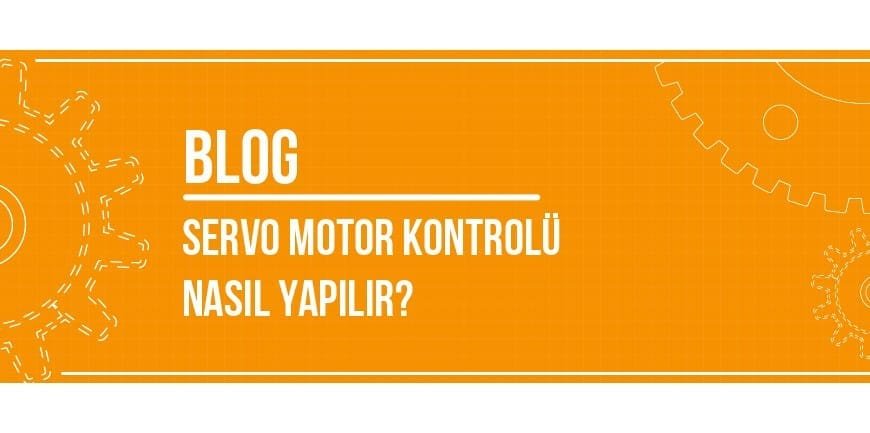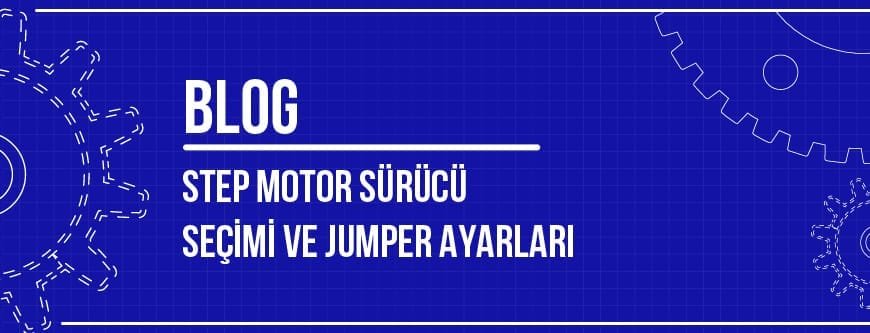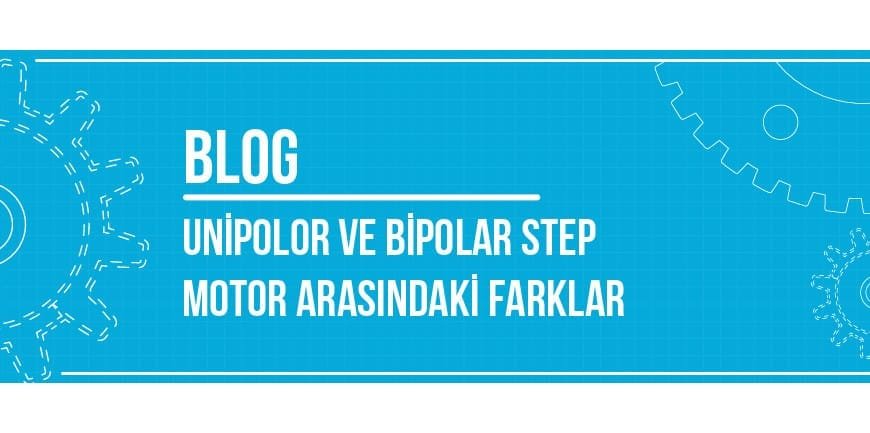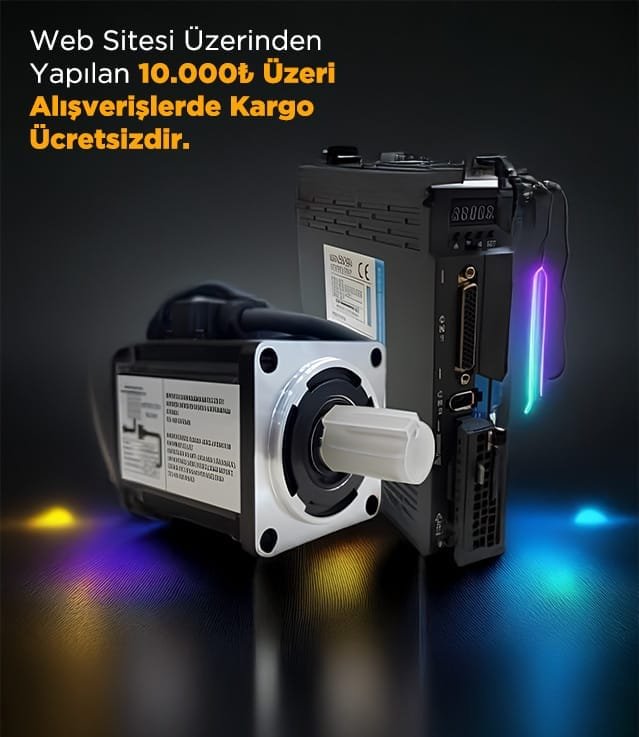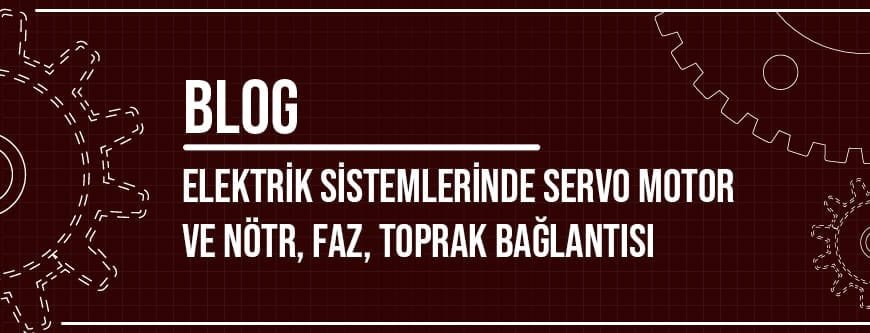
İçindekiler
Servo Motor and Neutral, Phase, Earth Connection in Electrical Systems
Motors that operate safely and efficiently in electrical systems play a critical role in a wide range of applications, from industrial automation systems to household appliances. Especially servo motors are among the preferred motor types in applications that require precise movement and high efficiency. However, in order for servo motors to operate correctly, it is of great importance that the electrical connections in the system are also made correctly. In this context, proper phase, neutral and ground connections ensure efficient and safe operation of the motor. At this point, you can take a look at our content for detailed information about servo motor and neutral, phase and ground connection in electrical systems.
Servo Motor Connection in Electrical Systems
Servo motor connections in electrical systems are divided into 2 separate categories. The first one is Power connections and the other one is Control connections. To examine these connection types separately;
- Power Connections
Phase
Phase cables are lines that are actively involved in the energy transmission of electrical systems. These lines, electrical systems usually have a phase cable and electric current is transmitted through this cable. Thus, the phase cable carries the electric current and provides the necessary energy to the devices. Another most important feature of this cable is to transmit electrical energy to the devices in the system.
Neutral
The neutral cable is a conductor line that provides the return path of the electric current. This line is a critical component for the current from the phase to return. For this reason, the Neutral wire is usually blue in color and, unlike the phase wire, does not actively conduct electricity in the circuit. In addition, the Neutral line ensures the proper return of energy in the circuit. This allows electrical devices to function properly.
Grounding
Grounding is a critical safety measure in electrical systems that ensures the safe operation of devices and the system. This safety measure ensures that the external surfaces of electrical devices and system components are connected to earth. Thus, in the event of a leakage current, the current is directed to earth and the device or user is not damaged. At the same time, Grounding prevents the risk of electric shock and helps the electrical system to function properly.
- Control Connections
PWM (Darbe Genişlik Modülasyonu)
PWM (Pulse Width Modulation) is a technique used for electrical power transmission and signal processing and is used in many applications, especially servo motors, LEDs, motor speed control. In this context, PWM allows to control the power level of a load by changing the “pulse width” of a signal. It also works by switching a digital signal on and off (duty cycle) at a specific frequency.
Feedback (Encoder or Resolver)
Feedback is a system used to monitor and control the position, speed or direction of a motor. These feedback signals are usually obtained through sensors such as encoders or resolvers. Encoders convert the rotational motion of the shaft into numerical data, usually using optical or magnetic sensing technologies, and this data is used to control the motor. Resolvers are sensors that provide more precise feedback, usually generating analog signals. These sensors are especially preferred in industrial applications that require high precision.
Signal Inputs and Outputs
Signal inputs and outputs are critical components for a servo motor control system. These signals are the signals used to control and monitor the motor. They can be of two main types: input signals and output signals. Input signals drive the motor, while output signals report back the state of the motor. The interaction between these two types of signals enables closed-loop control. For example, the motor receives a specific PWM signal (input signal) to run at a target speed. When the motor starts running, the encoder provides feedback and controls the speed of the motor (output signal). If the motor does not move at the expected speed, the system changes the PWM signal and brings the motor speed to the correct value.
How to Connect Servo Motor in Electrical Systems?
Servo motor connection is a process that must be done carefully for correct energy transfer and precise control. For this reason, first, the power connections of the servo drive are realized. The phase (L) line is connected to the power input of the servo drive, the neutral (N) line is connected to the same point to complete the circuit, and the ground (PE) line is securely connected to the metal body of both the drive and the motor to protect against the risk of electrical leakage. Then the PWM (Pulse Width Modulation) signal lines for the control connections are connected to the relevant ports of the drive to control the motor speed and direction, and all connections are run at low speed for testing. In this way, all connections are checked in detail.
Possible Problems and Solutions to Wrong Connection
Servo motors can sometimes be incorrectly connected to electrical systems. As a result, some problems may arise. These problems are quite easy to solve. These problems and solutions are as follows;
- Incorrect Phase and Neutral Connection
Incorrect connection of the phase and neutral cables of the servomotor can cause the motor not to start or to rotate in the wrong direction. In addition, incorrect connections can cause the motor to overheat or even fail. At this point, the Phase and neutral connections should be checked and pay attention to the color codes to ensure that the connections are correct. Color codes are generally red or brown on the phase cable and blue on the neutral cable.
- Incomplete or Inadequate Grounding
If the earthing line is missing or insufficient, the safety of the motor may be compromised. Failure to Ground in this case can lead to electric shock, motor overheating or feedback faults. In addition, the performance of the motor may be degraded. In such cases, in general, it should be ensured that the grounding connection of the motor is made correctly and that the grounding cable is properly connected to earth. This will ensure proper operation of the motor.
- Incorrect Feedback Links
The feedback system is used to control the position and speed of the servo motor. Therefore, incorrect feedback connections can lead to misdirection of the motor’s motion or incorrect feedback reception. It can also lead to undesired motor operation or loss of position.
- PWM and Control Signal Errors
The PWM (Pulse Width Modulation) signal controls the speed and movement of the motor. Errors in this signal can cause the motor to run erratically or not at all. In addition, an incorrect PWM signal can cause the motor to move slowly or quickly, overheat, or not turn at all, so to correct signal errors, the PWM signal must first be sent at the correct frequency and amplitude. Then check that the control board and the motor driver are compatible and fix any faulty connections or disconnections. Also, the software settings on the control board must be configured correctly.
- Incorrect Voltage or Current Supply
Supplying the servomotor with the wrong voltage or current can cause the motor to receive insufficient power and not operate properly. In addition, high voltage or current may cause the motor to burn out or fail. In this case, the voltage and current requirements of the Motor must be set correctly and the appropriate power supply must be selected taking into account the specifications of the Servo motor.
Servo Motor Connection Schematic
A servo motor wiring diagram is an organized diagram showing the electrical connections and components necessary for servo motors to operate correctly and efficiently. This diagram is usually connected to key components such as a control board, motor driver, potentiometer, power supply and signal cables. During connection, the power cable of the motor is usually connected to the positive and negative terminals, while the sinusoidal signal (PWM signal) and the feedback signal are the elements that enable the motor to be controlled. In this way r. The control board sends a signal that drives the motor, and the motor driver translates these signals into the correct voltage and current to make the motor rotate. In addition, feedback devices such as potentiometers or encoders are used to ensure that the motor runs in the correct position. In this connection diagram, the correct connection points and cable colors of each component are shown. Thus, the error rate is minimized when assembling the system and the correct operation of the system is ensured.
What Does Phase Neutral Earth Do?
Phase neutral earth is an important grounding method used to ensure safety in electrical systems and to ensure proper energy distribution. In this system, the electrical balance between the phase (active) line and neutral is maintained by connecting the neutral line in the electrical network to the earth. At the same time, the phase neutral earth ensures that electrical faults or leakage currents are safely transmitted to earth. Thus, it reduces the risk of possible electric shock and allows the devices to operate properly. It also plays a critical role in industrial plants, commercial buildings and electricity distribution networks by stabilizing voltage fluctuations in the system and ensuring efficient and safe energy flow. In this context, it is indispensable to ensure safer management of electrical faults and balance in the system.
What are the Differences Between Phase and Neutral?
There are certain differences between phase and neutral. These differences are very important for energy transmission and safety as the basic components of electrical systems. If we examine these differences, they are as follows;
Tasks and Functions:
- Phase (Active): The phase is the line that supplies the electric current. Electrical energy is transmitted through the phase cable and this line has a specific voltage level, usually 220V or 380V. The phase cable carries electric current to energy-consuming devices.
- Neutral The neutral provides the return path of the current from the phase. After the energy leaves the phase line and is used in the device, it returns through the neutral wire. The neutral line, unlike the phase, carries no electrical charge and is usually connected to earth. This ensures electrical balance in the system.
Voltage Level:
- Phase: The phase cable has a certain voltage difference with respect to the neutral, usually something like 220V or 380V. This provides the active energy that runs the devices.
- Neutral: The neutral line usually has the same potential as the earth and therefore has a voltage level of zero. For this reason, while the neutral allows the return of electric current, it does not play an active role in energy transmission.
Connection with Grounding:
- Phase: The phase wire does not need to be connected to earth. The phase wire therefore only carries electrical energy.
- Neutral: The neutral is usually connected to the earth ground. This ensures that leakage currents are safely conducted to earth and that electrical charges that may build up on the external surfaces of electrical devices flow to earth.
Physical Properties:
- Phase: The phase cable is usually colored (such as black, red or brown). Thus it is easily recognizable.
- Neutral: Since the neutral wire is usually blue in color, it is used as a marker to distinguish it from the phase wire.
Connection Points:
- Phase: Phase is the connection required to supply electricity to devices and must always be connected to the phase line for the device to work.
- Neutral: The neutral forms the return path of the electricity coming from the phase and every device must have a neutral as well as a phase, because the electric current must run in a continuous loop.
How does a Grounding Line Work?
The earthing line is a critical component used to ensure safety in electrical systems and to ensure that leakage currents are safely routed to earth. This component provides the connection of the outer bodies or conductors of electrical devices and systems to earth. Thus, in the event of a possible fault, it makes it possible to safely conduct the electric current to earth. It also eliminates the risk of electric shock and protects users.
The system is usually connected to earth through a metal rod or plate called a ground electrode, which allows the grounding line to absorb energy and transmit it safely. As a result, electrical leakage currents are directed to earth through the earthing line, preventing damage to electrical components in the rest of the system. In addition, it minimizes the risk of electric shock and safeguards users
Are Neutral and Earth Connected?
Neutral and earth can be connected together. However, this connection must be made in accordance with certain rules and safety precautions. For this, it is important that it is done by experts. In this context, Neutral represents the line where the electricity returns, while grounding is a conductive line placed in the electrical system for safety purposes. The connection between neutral and earth is usually made at the main earthing point (usually at the substation or electrical panel). Making this connection correctly ensures that the electrical system maintains stability and increases user safety. However, the connection between neutral and earth must be made carefully. Otherwise a wrong connection can lead to serious electrical problems. Therefore, local electrical safety standards and regulations must be observed to ensure that the grounding and neutral connection is made correctly. In electrical systems, it is critical for safety that this connection is made by experts.
What Happens When Neutral and Earth Join?
If neutral and earth are connected, serious safety and functional problems can arise in the electrical system. Normally, the connection between neutral and earth should only be made at certain points, usually in the electrical panel or substation. If neutral and earth are connected incorrectly, several important problems can occur. First of all, it can lead to voltage fluctuations and imbalances in the electrical circuit. In addition, problems such as electric shock may occur. This is because the grounding line also becomes an energy-carrying line and anything connected to the ground can contain electricity. In addition, electrical faults and the risk of burns can also pose a significant danger and lead to high voltage situations. . For this reason, it is vital that the connection between neutral and earth is made correctly by specialists.
Where is the Neutral Cable Connected?
The neutral cable is an important component in electrical systems that aims to ensure safe transmission of energy and balance in the circuit. For this reason, it is usually used in electrical panels and distribution transformers by connecting to ground. In addition, the main task of the Neutral cable is to provide the return path of the electric current transmitted through the phase cable and to ensure that this current maintains the balance in the circuit. In this context, the Neutral cable is connected to the grounding system at the point where it meets the grounding line, and the possible leakage currents in the system are safely directed to the ground.
You can also choose the most suitable servo motors you can contact the reliable team of Şahin Rulman. In this way, you can get maximum efficiency in your work.
What are the challenges in the integration of servo motor and neutral, phase earth connection?
Difficulties that can be encountered in the integration of servo motor and neutral, phase, ground connection are usually caused by incorrect connections and electrical imbalances. Therefore, the connections must be very careful. Otherwise, possible voltage fluctuations, overvoltage and EMI (electromagnetic interference) problems may occur.
How to optimize the use of servo motors in electrical systems?
To optimize the use of servo motors in electrical systems, several basic steps can be followed. Firstly, the correct connections must be ensured; proper phase, neutral and earth connections ensure safe and efficient operation of the motor. Furthermore, the earthing system must be proper and electrical loads accumulated on the external surfaces of the motor must be safely conducted to earth. In addition, efficiency can be increased by using voltage stabilization devices and current monitoring systems to protect the motor against overvoltage and surges. Thus, all these measures extend the life of the servo motor and ensure safer and more efficient operation of the system.
Diğer Blog Yazılarımız



